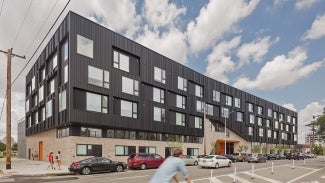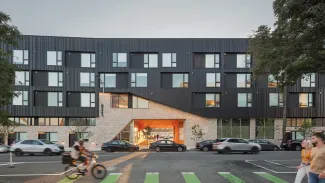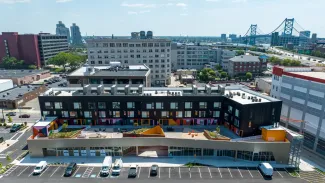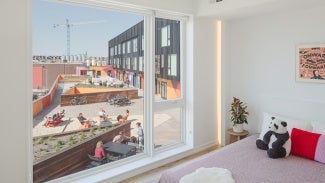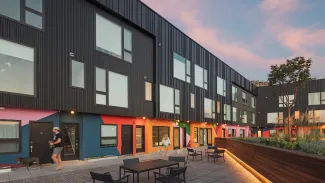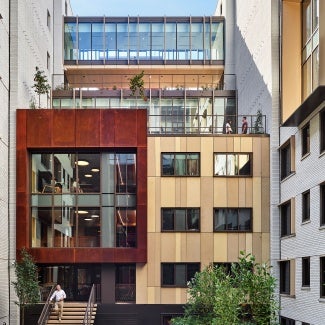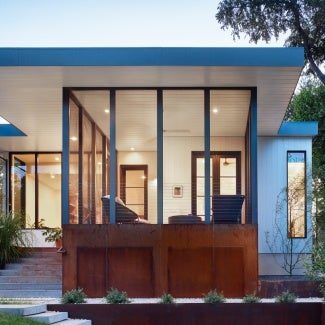The Block
The award-winning housing design of The Block in Philadelphia, PA demonstrates an innovative low-rise and high-density approach to urban housing with potential applications for communities across the country.

Project highlights: The Block
- Architect: ISA - Interface Studio Architects
- Owner: Alliance HP
- Location: Philadelphia
- Category: Mixed Use Community Connection
- Project site: Previously developed
- Building program type(s): Mixed Use
Along one of Philadelphia’s major north-south connectors, The Block adds 49 apartment units through a building that successfully navigates the rift between the pedestrian-focused and car-centric realms. At a moment when many cities are struggling with soaring land and construction costs, The Block demonstrates an innovative low-rise and high-density approach to urban housing with potential applications for communities, both urban and suburban, across the country.
Though Philadelphia is known for its walkability and dense urban fabric, there still exist car-centric commercial developments where big-box buildings on former industrial lots deliver retail amenities to historically underserved neighborhoods. This project bridges the gap between both conditions by supporting walkability and capitalizing on existing car-centric development. In place of high-rise luxury towers and their steep costs, the project probes the upper limits of lower-cost wood-frame construction types.
The Block was developed by the owners of a single-story warehouse that’s been transformed into a local brewery and retail space and sits immediately to the new building’s north. The owners approached the design team in 2017 seeking a concept that would add value and activity to the southeast edge of the parcel. To address the challenge of shaping a compelling living experience for city residents within a sea of surface parking, the team envisioned a broad mix of programming, including 11,000 square feet of ground-floor commercial space sized to welcome smaller, local tenants.
The new building, set along the site’s southern edge, occupies the majority of the existing parking lot and lines 5th Street with live-work units. Taking cues from Philadelphia’s low-rise rowhouse typology, the team employed an unusual approach to circulation throughout the building. The Block’s interior corridors are minimized, relying instead on an elevated terrace as the primary access point for the walk-up apartments. The terrace buffers the apartment entries from the surface parking lot and retail operations below and includes outdoor amenities off the central lobby and the building’s club room. From its decked seating areas, gravel lounge pits, and a turfed dog park, residents can enjoy views of the city’s skyline.
Since its completion last year, all of The Block’s apartment units have been occupied, and numerous commercial leases have been signed. The owners remain committed to Philadelphia’s entrepreneurs and offer retail spaces for weekend pop-ups that attract nearly 100 vendors and makers. The apartments add much-needed pedestrian-friendly housing adjacent to transit and the city’s vibrant Old City and Chinatown neighborhoods.
Framework for Design Excellence measures
Was there a design charrette? Yes
Site area that supported vegetation (landscape or green roof) pre-development: 1%
Site area that supports vegetation post-development: 5%
Site area covered by native plants supporting native or migratory species and pollinators: 5%
Strategies used to promote Design for Ecosystems: Habitat conservation, flora/fauna
Is potable water used for irrigation? No
Is potable water used for cooling? No
Is grey/blackwater reused on-site? No
Is rainwater collected on-site? No
Stormwater managed on-site: 100%
2030 Commitment baseline EUI: 58 kBtu/sf/yr
Predicted net EUI including on-site renewables: 33 kBtu/sf/yr
Reduction from the benchmark: 43%
Is the project all-electric? Yes
Level of air filters installed: MERV 9-11
Was a “chemicals of concern” list used to inform material selection? No
Do greater than 90% of occupied spaces have a direct view to the outdoors? Yes
Were embodied carbon emissions estimated for this project? No
Estimated service life: 50 Years
Floor area, if any, representing adapting existing buildings: 0%
Ability to survive without utility power: Passive survivability
Which of the following risk assessment and resilience services were provided? None of the above
Has a post-occupancy evaluation been conducted? No, and a POE will not be conducted
Building performance transparency steps taken: Present the design, outcomes, and/or lessons learned to the office
Project team & jury
Year of substantial project completion: 2022
Gross conditioned floor area: 58200 sq. ft.
Architect: ISA
Owner/Developer: Alliance HP
Engineer - Structural: Cooke Brown Structural Engineers
Engineer - Electrical: Holstein White Inc
Engineer - Mechanical: Holstein White Inc
Engineer - Civil: Bohler Engineering
Landscape Architect: Jonathan Alderson Landscape Architects, Inc
General Contractor: Callahan Ward
Lighting: Lam Partners
Photographer: Sam Oberter
Drone Photographer: Plural VR
Catherine Baker, FAIA, Chair, Nowhere Collaborative, Chicago
John DeForest, AIA, DeForest Architects, Seattle
Brian Lane, FAIA, Koning Eizenberg, Santa Monica, Calif.
Amit Price Patel, AIA, DIALOG, Vancouver, British Columbia
Michael D. Robinson, AIA, Robi4 Architecture & Planning, San Diego
The Housing Award emphasizes good housing as a necessity of life, a sanctuary for the human spirit, and a valuable national resource. Recipients show the world how beauty, safety, sustainability, and comfort can come together.
Ten projects showcase the best in housing design.

